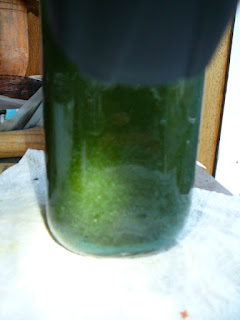I came across lakes while trying to find a way to make natural red pigment. I'd already dyed with madder in the past, but simply powering the root doesn't work. I wasn't even sure if madder would be the best choice. Then I discovered Madder Lake.
It has no coverage, that is, it can't be used by itself to just cover up a color, but it is red, it is natural and it does work.
Laking can be done with almost any plant that has enough strong coloration to make pigment. In the simplest terms, a "lake" is using a chemical reaction with alum and some base, lye, chalk or soda ash, to bind the colorants in a stable form. Most lakes are made by soaking or boiling the plant material until a dark pigment saturated liquid is made.
Then one dilutes alum with a small amount of water and adds it to the pigment. Often, though not always, there is a color shift, usually to a richer more saturated hue. But sometimes the liquid is just too dark to tell. To this alum mixture is then added a diluted base. Sometimes, like with chalk, there is a vigorous reaction. But usually there is just an interesting, but not messy, swirling of the contents as the alum and base bind together.
Proportions are important: too much of one or the other and the color is weak or pastel. Or their is a lot of whitish debris that increases washing time. Generally more alum is used than the base, but exact proportions vary on the kind of base.
Once the reaction is complete, the liquid will be filled with a colloidal solid. This will take a while to settle, often hours, if not a couple fo days depending on the pigments involved. After it settles, it's washed, that is the liquid is poured off consecutively until the water is clear and the settled solid can be strained and dried. One can also save the first pour off to make another, paler, lake.
This opens up a wealth of natural pigment possibilities. But their are caveats. Many plant based pigments are not colorfast. There are exceptions: madder, weld, woad. Really anything that has a reputation as a colorfast dye will probably make a colorfast lake. The color will be different: madder is pleasantly true red but woad becomes a dark teal. The advantages of lakes, once they are dry, is they can be stored indefinitely, though one probably should keep them out of direct light. When one was ready, they were ground and mixed with water and gum arabic to make a water color, or ground into oil for oil paint.
So this was exciting. I could, in theory make pigment out of anything. But I discovered this is February, when few plants are available. Then I remembered the dye baths I'd saved.
There was a lot of mullein and a medium jar of madder. They were stored in a cold place in the garage and hadn't fallen prey to mold. So I experimented. It turned out to be the best thing, experiment with old dye baths. Mistakes could be made that would have made me very sad with fresh, high quality madder roots. Like when it when pink, for instance:
According to these forums pink madder is the worst. I'm not a fan of pink, so I tend to agree. The whole point of madder is making red. But pink is a useful pigment to have on hand, so lemons, lemonade, etc.
My drive was an inspiration for a Book of Kells project where I'd use just natural pigments. Learning to lake pigments made that idea possible.







